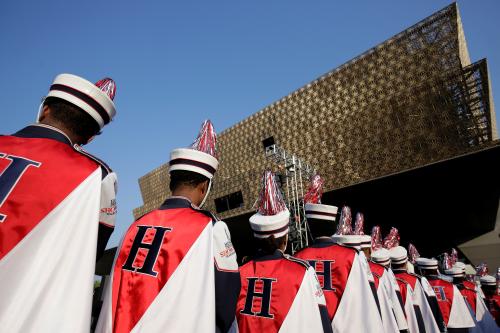How does your college stack up in terms of Middle-Class Mobility? Use the interactive to find a specific institution and investigate how a school’s selectivity, size, or sector impacts students’ future economic outcomes. The following report uses Opportunity Insights’ data to examine intergenerational mobility, specifically for the middle class.
Introduction
Inequality in the United States has been rising in recent decades, while intergenerational mobility remains low. This means that absolute mobility—the extent to which children are economically better off than their parents—is declining, and intergenerational inequality is increasingly entrenched. A long literature suggests large returns to attending college and points to the importance of higher education for intergenerational mobility. Recent work by Opportunity Insights explores in more detail the role that different colleges play in promoting upward mobility, pointing to significant differences across colleges in the extent to which they enroll students from low-income families who have high earnings as adults. Here, we use the data produced by Opportunity Insights to focus specifically on students from middle-class families to understand patterns of attendance and upward mobility for the middle class.
Building on the College Scorecard Data compiled by the U.S. Department of Education, the Opportunity Insights Mobility Report Cards use de-identified data from tax returns, linked to information about colleges, to construct a publicly available database for colleges in the United States. Although they provide many measures in the Mobility Report Cards, the Opportunity Insights team focuses primarily on upward mobility for the lowest-income students—those whose parents’ income falls in the bottom quintile—and on the likelihood that those students make it all the way to the top earnings quintile as young adults. This “Bottom-to-Top” measure of mobility is important, but it is not the whole story. It is important to also consider the prospects for students from a broader range of the income distribution, and in particular from middle-class families.
The Bottom-to-Top Mobility (BTM) measure depends on both how many bottom-quintile students a college enrolls (bottom-quintile “access”) and what proportion of those enrolled bottom-quintile students reach the top earnings quintile in adulthood (“success”). Colleges with low access for bottom-quintile students have relatively low BTM even if those who do enroll have high upward mobility; conversely, colleges where low-income students are not upwardly mobile have low BTM even if they enroll many low-income students.
We develop an analogous measure of Middle-Class Mobility (MCM), focusing on upward mobility for students from middle-income families. Our measure is the share of students at a college who come from the middle quintile of the parental income distribution—and move up at least one quintile in adulthood. (Note that throughout this paper, we use the term “middle class” to refer to the middle quintile.) We also adjust this measure to account for downward mobility and for typical mobility among students who do not attend college at all, discussed further below.
Key findings
- Middle-Class Mobility varies substantially across colleges.
- Colleges with high Bottom-to-Top Mobility do not necessarily have high Middle-Class Mobility, and vice-versa; the correlation between the two measures is just 0.26.
- Selective four-year colleges have the highest rates of Middle-Class Mobility on average, followed by nonselective and highly selective four-year colleges, then two-year and for-profit colleges.
- Public and private four-year colleges have similar average Middle-Class Mobility rates, but public four-years contribute substantially more to upward mobility overall because they enroll many more students.
- Two-year colleges account for a smaller share of total Middle-Class Mobility (31 percent) than their share of middle-class enrollment (43 percent). But per-student instructional spending is lower and students in these colleges spend fewer years in college, on average, so the sector nonetheless accounts for a large share of net upward mobility compared to its share of total spending, just 11 percent.
- Conversely, highly selective colleges account for a disproportionate share of net upward mobility compared to enrollment. But they have high per-student instructional expenditure, so they account for a larger share of spending than Middle-Class Mobility.
- Selective four-year colleges are the workhorses of upward mobility for the middle class, accounting for 34 percent of middle-class enrollment, 50 percent of spending on middle-class students, and 43 percent of Middle-Class Mobility.
Becca Portman created the interactive for this report.
The Brookings Institution is committed to quality, independence, and impact.
We are supported by a diverse array of funders. In line with our values and policies, each Brookings publication represents the sole views of its author(s).









